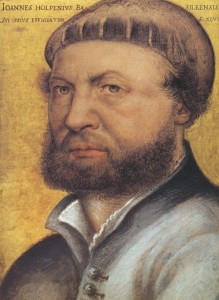
Holbein, self-potrait
Hans Holbein the Younger is one of history's most famous painters and it is thanks to his great skill and talent that we have so many paintings of the people of Henry VIII's reign, including the great King himself. But who exactly was Hans Holbein the Younger and how did he come to the English court and catch the eye of Henry VIII?
Holbein was born in 1497/98 in Augsburg in southern Germany to Hans Holbein the Elder, who was himself an extremely talented painter and artist. Hans Holbein's Uncle Sigmund was also a talented painter and it was through working with his father and uncle that Holbein learnt his craft. In 1515 at the age of seventeen Hans Holbein moved to Basel in modern-day Switzerland where he sought work in various fields, including as a book illustrator, a painter, working with stained glass and making woodcuts. It was here that Holbein learnt to have a joke at the world and to insert hidden messages within his drawings – this is a quality that the painter would later use within some of his most famous paintings. Holbein quickly gained a name for himself and was sought after to paint many religious paintings. During this period of time Holbein married Elsbeth Schmid who would give Holbein two children.
In 1519 Holbein joined the painters' guild in Basel and in 1520 became a burger, or citizen, of Basel. While living in Basel, Holbein also travelled - going to Northern Italy in 1517 and France in 1524. In 1523 Holbein painted the portrait of the great scholar Erasmus. He made an important connection with the famous scholar that would soon help him make his way to England.
Things changed for Holbein as Martin Luther and his new religious teachings began to take hold throughout the country and soon there was little call for Catholic based paintings. Holbein needed to find work somewhere else and it was Erasmus that guided Holbein to England.
In 1526, Hans Holbein left his wife and son in Basel and went to England with a letter from Erasmus in search of work. Amazingly with all his experience in painting and art work, Holbein had little experience in painting portraits. This was in conflict with the love of portraiture in England and Holbein quickly had to refine his skills and become a portrait painter. In England, Holbein met Thomas More and stayed with him for a period of time, painting Thomas More and his family during his stay.
In 1528, Holbein had to leave England and return to Basel otherwise he would lose his citizenship. In 1529, Basel officially became a Protestant city and tragically many of Holbein's Catholic paintings were destroyed. It has been suggested that during his second stay in Basel Holbein converted to the new faith, although it has been questioned how deep these convictions ran or if Holbein simply made a show of converting to the new faith due to the religious beliefs of the city at the time.
In 1532, Holbein returned to England once more, leaving his wife and children behind, and gained a great deal of work painting members of the Germany community. Holbein officially started working for Henry VIII in 1535 and was paid £30 a year. Unfortunately, when Thomas More fell from favour and was executed Holbein had to look for a new patron and it was with Anne Boleyn that Holbein found favour. As well as working for Anne Boleyn, Holbein was commissioned to do several pieces for Thomas Cromwell, Henry VIII's right hand man, including Cromwell's famous portrait which still survives today. In addition to portraits, Holbein designed jewellery, cutlery, daggers, fireplaces and building structures.
Famously, Holbein was commissioned to paint portraits of the women that Henry was interested in for his fourth marriage, including Christina of Denmark and Anne of Cleves (who Henry would end up reluctantly marrying). Holbein had a great weight on his shoulders as it was his job to accurately represent these women and send their likeness back to Henry VIII.
Hans Holbein's most famous painting, commonly entitled "The Ambassadors", is of Jean de Dinteville, Seigneur of Polisy and French Ambassador at the English Court, and Georges de Selve, Bishop of Lavaur. This is an amazing piece of work as there are many hidden meanings and messages added into the painting. Holbein's hidden messages within this painting may refer to the fleetingness of life and how earthy goods are wonderful in life but are worthless in death. There has also been some suggestion that within the painting Holbein also subtly implies the discord of Martin Luther and his new religion, and the idea that Lutheranism was just a passing phase.
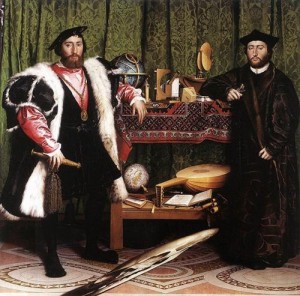
Holbein's Ambassadors
Holbein's portraits of Henry VIII were not simple portraits, they were images of propaganda. They showed the king in his full glory - majestic, strong, tall and powerful. They were painted to show Henry VIII as he wanted to be seen and remembered, rather than perhaps the way he was at the time - an ageing, ill man. It is a true testament to the skill of Holbein that he was able to create such awe-inspiring images of the king, which not only are the most memorable images of Henry VIII today but that have been reproduced and copied countless times throughout history. The Whitehall Mural, showing the iconic image of Henry VIII face-on, hands on hips and legs spread, was destroyed in a fire in the 17th century, but we still have Holbein's cartoon of the mural and a number of copies of Henry from the mural. Madrid's Museo Thyssen-Bornemisza is home to Holbein's surviving head and shoulder's portrait of Henry.
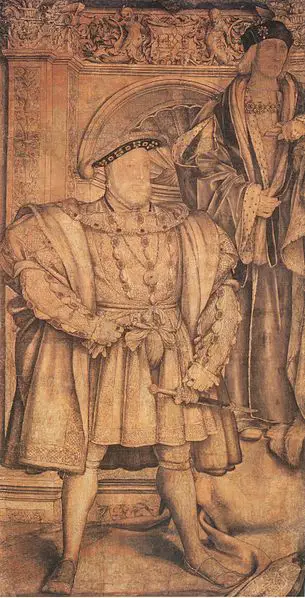
Detail from Holbein's cartoon of the Whitehall Mural
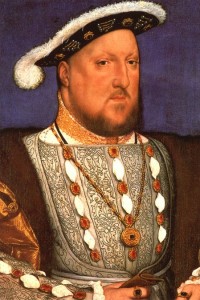
Holbein's survivijng portrait of Henry VIII
Holbein tragically died sometime between October 7th and November 29th 1543, from what is believed to be the sweating sickness or the plague. Hans Holbein painted such famous Tudor personalities as Henry VIII, Anne of Cleves, Jane Seymour, Edward VI as a baby, Thomas Cromwell and Thomas More. Holbein was an extremely talented portrait painter. His work shows remarkable details of the sitter's faces, their clothing, even the fine brushstrokes of their hair. He was an extraordinary man who we in modern times owe a great deal of thanks to for if it was not for Hans Holbein we may not have such intricate and famous portraits of some very famous Tudor personalities.
Sources
- Hans, the Younger Holbein The Complete Works 2015, Hans, the Younger Holbein The Complete Works, viewed 27 February 2015, http://www.hans-holbein.org/.
- Hans Holbein the Younger 2015, The National Gallery, viewed 27 February 2015, http://www.nationalgallery.org.uk/artists/hans-holbein-the-younger.
- Harbison, C 2014, Hans Holbein the Younger, Encyclopaedia Britannica, viewed 27 February 2015, http://www.britannica.com/EBchecked/topic/269121/Hans-Holbein-the-Younger.
- Holbein: Eye of the Tudors 2015, British Broadcasting Company, United Kingdom. Presented and Directed by Waldemar Januszczak.
Further Reading
- The Ambassador's Secret: Holbein and the World of the Renaissance, John North
- Hans Holbein: Portrait of an Unknown Man, Derek Wilson
Sarah Bryson is a researcher, writer and educator who has a Bachelor of Early Childhood Education with Honours and currently works with children with disabilities. She is passionate about Tudor history and has a deep interest in Mary Boleyn, Anne Boleyn, the reign of Henry VIII and the people of his court. Visiting England in 2009 furthered her passion and when she returned home she started a website, queentohistory.com, and Facebook page about Tudor history. Sarah lives in Australia, enjoys reading, writing, Tudor costume enactment and wishes to return to England one day. Sarah is also the author of the forthcoming book Mary Boleyn: In a Nutshell.


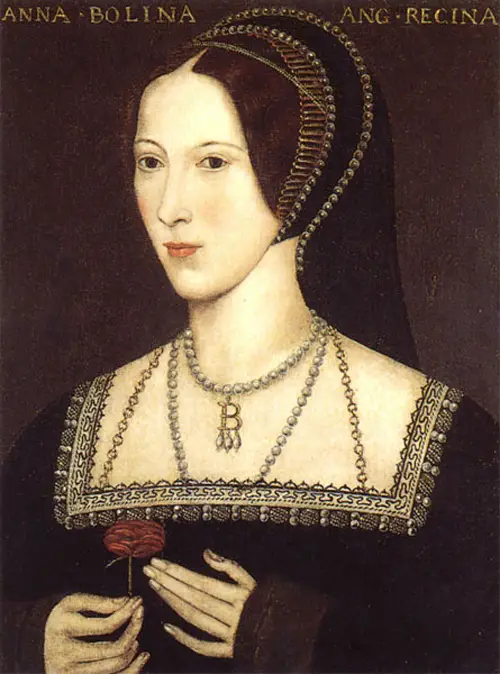

Leave a Reply